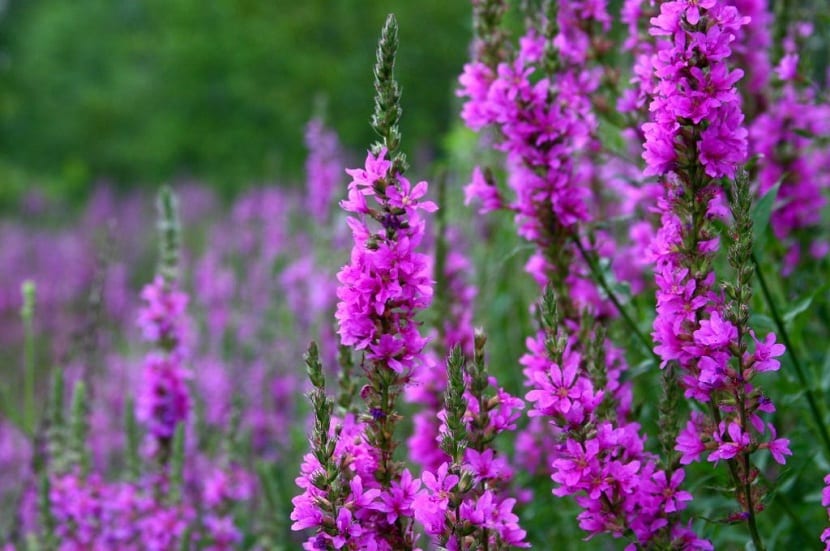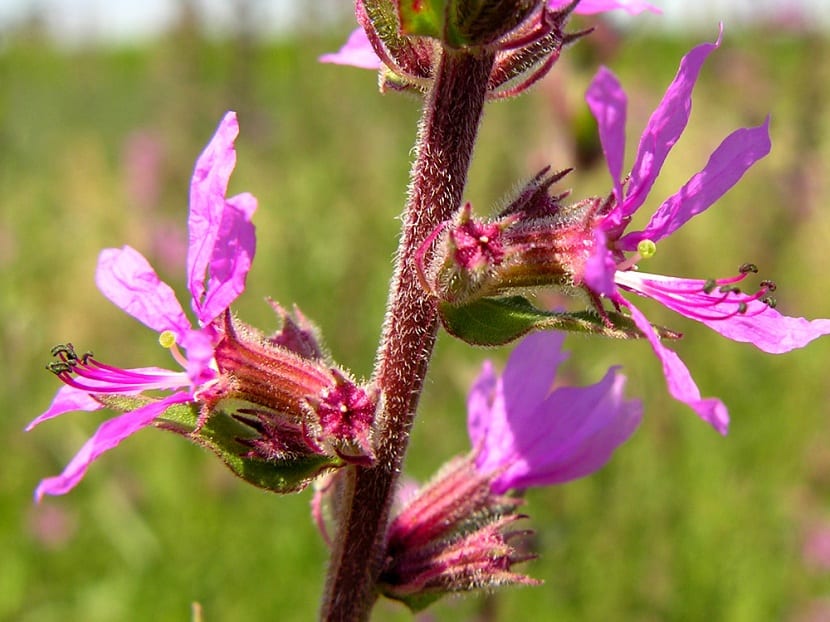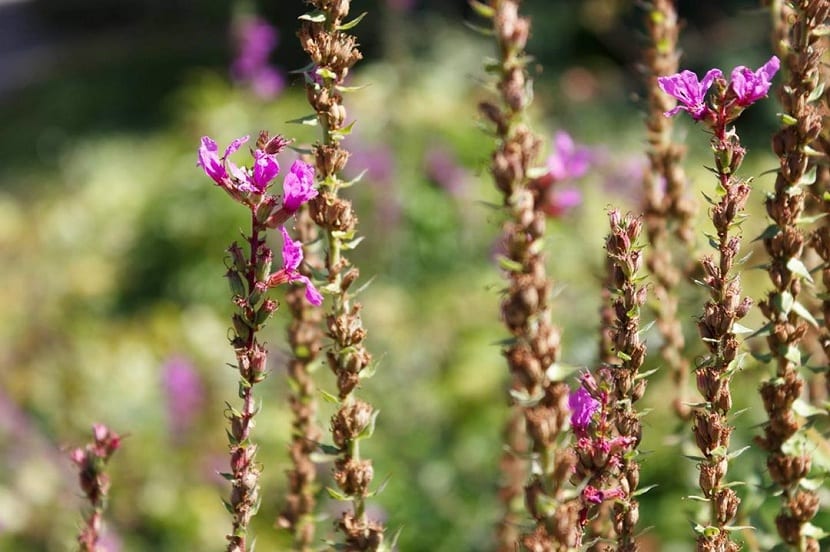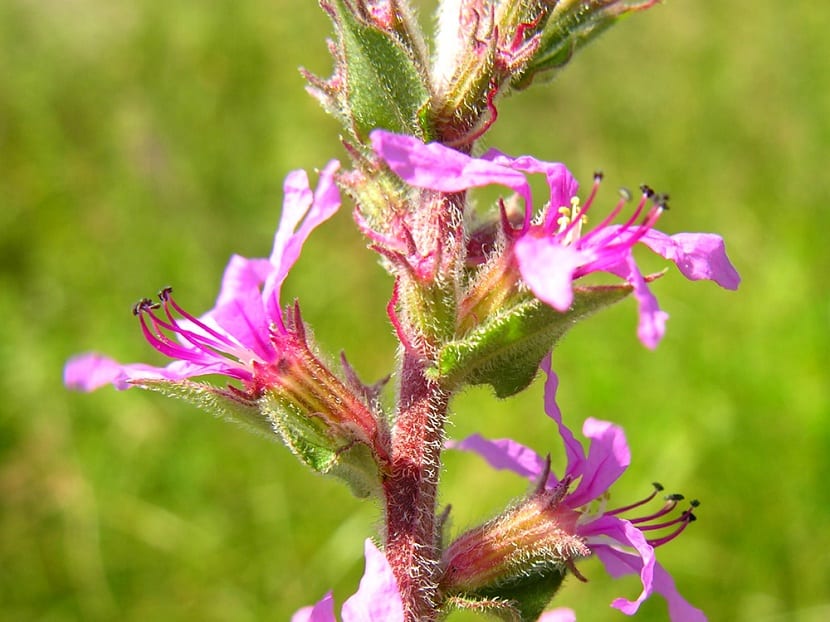
One of the semi-aquatic plants that is used to decorate the garden is the A bottle of willow. It is an herb that belongs to the Litráceas family and is known by common names such as arroyela, loosestrife and puffin. It comes from the humid areas of Eurasia and usually grows spontaneously on our peninsula in the most humid areas. Being so special, it is included in the list of the 100 most harmful invasive alien species in the world by the IUCN.
We will talk about why it is so harmful, what its characteristics are and what care it needs. Do not miss this tab of Lythrum loosestrife.
Key features

When this plant is in its natural habitat, We can find it on the banks of streams, edges of ditches or wetter meadows. In short, wherever there is humidity, this plant has the necessary conditions to develop well. For those who want to have it in their garden for decoration, you just have to place it to decorate flower beds, pots and borders. These places must maintain a good level of humidity and be located near a watercourse, pond, lagoon, etc.
It is perfect for those gardens that have a small pond with fish, since it could become the riverside vegetation of said pond, giving a pretty good decoration touch. Another option is that the soil you have is relatively easily soaked with water. This, as we see in almost every article, is counterproductive for most plants, since they need the soil to drain well. Otherwise, the roots will suffocate and the plant ends up rotting. In this case, the A bottle of willow it needs soils impregnated in water or whose irrigation is sufficiently abundant and frequent to satisfy its needs.
It is a perennial plant that can reach up to 2 meters in height if conditions are favorable and its care is adequate. It has dark green leaves, lanceolate, opposite and whole. Its flowering takes place in summer and its flowers are distributed in purple spikes. This mixture is what makes the plant have enough potential as a decoration surrounding waterways or ponds.
Among the light needs we can find that it can be from little shade to full direct sunlight. It is interesting to protect the base of the plant during the coldest times of winter, especially if there is a frost. Thus, we will be improving and favoring roots. One of the properties that makes it such a harmful invasive plant it is because it has great resistance to pests and diseases.
Uses of A bottle of willow

Since this plant has various medicinal and nutritional properties, it is widely used in many areas. We are going to describe what these areas are so that they get better at the idea:
Medical uses
We divide its uses in the field of medicine. As it has a high content of loosestrife, it is a plant that can be used as an astringent. Thanks to this, we can cure dysentery and diarrhea treatments at any age.
For typhus disease, several studies have stated that the A bottle of willow it is an excellent antibiotic to treat this disease. What's more, It is an excellent natural disinfectant for the intestines that are suffering from enteritis.
One of the properties for which it was used a lot in ancient times is its ability to stop various hemorrhages. It also has an external use, as it is for cleaning eczema and wounds. Its properties help to heal and it is ideal for vaginal washing. For people with varicose ulcers, it is quite interesting for its hemostatic action.
Nutritional uses
In the realm of nutrition it also has some pretty cool uses. The young shoots are used for consumption as well as the marrow of the boiled stems. It is advisable to boil them in combination with some legumes to enhance their properties. CWith its leaves you can also prepare a good tea. The leaves are rich in calcium.
Care A bottle of willow

Now we are going to explain what care this plant would need if we had it in our garden as a decoration for pond edges. Being mainly in humid areas, they are ideal to keep near waterways and not have to take care of them too much. Apart from its great need for water, it is not a plant that needs much more care.
It is an invasive plant and usually stands in front of the rest of the other plants. Thus, its spread may need to be controlled. One of the easiest ways to control the spread of this plant is to prune the thallus that are in bloom before the end of summer. In this way we prevent the seeds from maturing and being able to disperse.
If you see some small looses that are still young starting to appear and they are not the specimens you want, pluck them immediately before they can begin to bloom. To cultivate the A bottle of willow it is necessary to know that the seeds are sown in spring time and in a humid ground. The place to plant it is an area with moderate sun and that has enough humidity to survive.
To multiply it, it can be done both by seeds and by division of the bush in spring. Being resistant to pests and diseases, it is easy to spread. For when the lower temperatures of winter arrive, it is advisable to cover them from the base to promote their growth and protection. Ideally, the plant takes advantage of the humidity of the winter rains. Even so, it will need abundant watering, especially if you have not placed it near a watercourse, pond or lagoon. As not all gardens can afford to have a pond and maintain it (especially if there are fish), you will only have to leave an area of the garden with more humidity to maintain this plant.
I hope that with these tips you can take good care of A bottle of willow and it can be used to decorate pond areas.